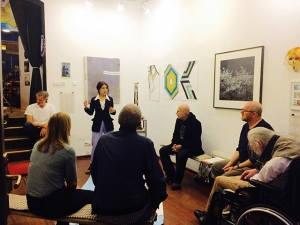Freeing Contemporary Art Presentation - Escape from Fixed Structures
Op-Ed
Curator Lily Fürstenow, founder of the ARE/Artistic Research artists group, has long been watching the barriers that confront artists in Berlin. Together with ARE, she initiated the Protest movement to get answers from local art institutions and citizens, asking questions such as, Why do local art museums and municipal galleries not show truly contemporary art?, Why is there no fresh change in the staff structure of publicly funded institutions? and What chance do citizens have to raise doubts about publicly funded projects in art institutions?
That's interesting: Why do the citizens of a district not themselves decide which art they want to see in their communal gallery financed by tax-payers’ money? There could be a democratic process. Basically, artists from the respective district could also rotate as curators and supervise the exhibitions for one term of office at a time.
Fürstenow is now trying to come up with actions and proposals in association with artists as part of her "protest" initiative. I saw them resolute as well as creative and open-minded in September, with their side event protesting the Berlin Art Week at GH36 art space. One goal is to bring the district offices to the table, to talk about free exhibition spaces, current art, democracy, exhibition costs, artists’ honorariums or other support. On the one hand, Berlin advertises its “creativity image,” from start-ups to tourism, but on the other hand, artists will soon be struggling to live and work there.
A second goal is to create production spaces, to make the long-term offices of the heads of the municipal galleries and art spaces more transparent and to manifest a critical counter-position to the art market at this level.
What is the situation? Who decides what? And what is perceived as contemporary art, by whom? First of all: there more art today than ever before. And the Berlin municipal galleries are already beginning to break up, but, for example, as a matter of principle, they only promote unknown artists! It is difficult if the curator now curates a thematic exhibition and certain positions are not allowed, because these artists already have a certain standing in the market. In many calls for applications and project grants, the applications are generally accepted by the participatory working artists because the “painters can also hang their pictures in galleries.” In other awarding procedures, the result (an exhibition of 15 or 30 positions) immediately makes it clear that a certain minimalism or white cube style corresponds to the current taste of the Board of Trustees. Or museum directors exclude artists for personal reasons. It has always been so, which is terrible, because we need trust for art.
If you ask citizens about art, the answer is always oriented to the shows in the big museums. The big museums in turn follow the art market, and are unfortunately far too busy with their statutes and depots. In addition, there are numerous art consultants and managers who unfortunately do not orient their advice to the collection of the buyers or collectors, but to gallery owners or artists, with whom they have commission agreements. Apart from the secondary market and Instagram, it is difficult to form any opinion.
In general, therefore, the question for ‘Protest’ initiator Lily Fürstenow, and the demand for art houses that the taxpayers finance to show a good mix of local and international artists of today from all genres, is both absolutely legitimate and necessary. In any case, I wish Lily Fürstenow and her team, along with as many different artists as possible, to have as many decision-makers as possible at the table to exchange views and rethink strategies that have been taken. Municipal, non-commercial art venues should offer a little more space for "art as a place of trust" than the so-called art market does. And just as museums are finally having to deal with digital reality and realign their conceptions, decisions about exhibitions must no longer be dependent only on the opinions of (long-established) directors or employees. Rotation principles or surveys and more transparent procedures are important.
Art is enshrined in Germany’s Basic Law, Article 5 GG., as a free activity, also free from earning revenue. "Money making" is alien to the nature of a true artist. He/she has to do it anyway. Art is not exclusive, but rather something very social, even archaic.
It is always tricky to meet everyone's demands. And it has always been dangerous to exclude certain groups of artists – whether avant-garde, "degenerate", not ideology apt or too traditional.
By Jana M. Noritsch (CEO Collectors Club Berlin)











